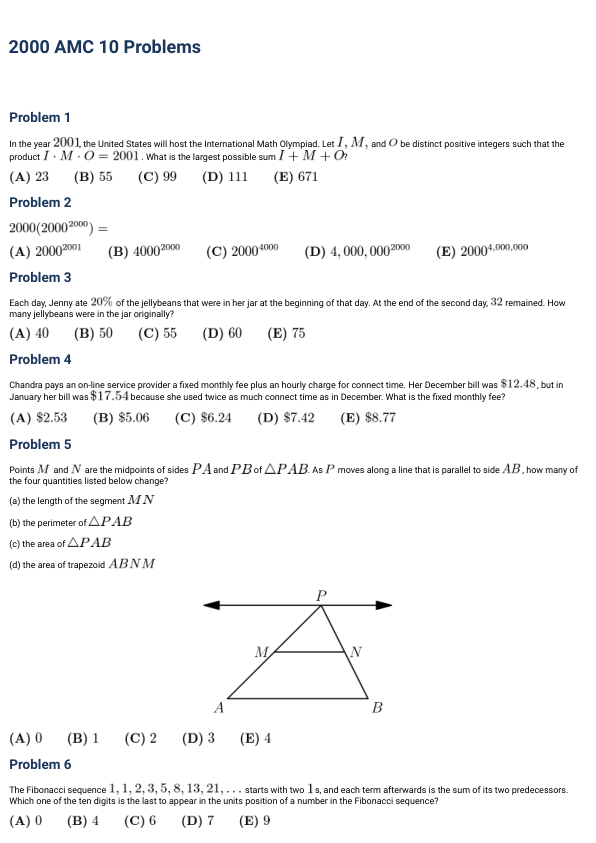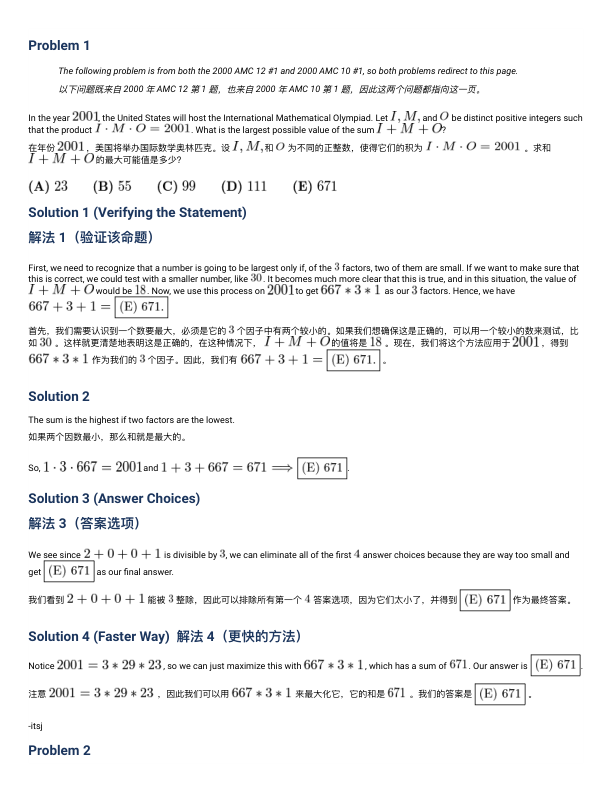2000 AMC amc10 真题 答案 详解
| 序号 | 文件列表 | 说明 | ||
|---|---|---|---|---|
| 1 | 2000-amc10-paper-eng.pdf | 5 页 | 199.74KB | 英文真题 |
| 2 | 2000-amc10-key.pdf | 1 页 | 9.93KB | 真题答案 |
| 3 | 2000-amc10-solution-eng.pdf | 17 页 | 830.44KB | 真题文字详解(英文) |
| 4 | 2000-amc10-solution-eng-zh.pdf | 26 页 | 995.60KB | 真题文字详解(中英双语) |
英文真题
2000 AMC 10 Problems
Problem 1
In the year 2001, the United States will host the International Math Olympiad. Let I, M, and O be distinct positive integers such that the product I · M · O = 2001. What is the largest possible sum I + M + O?
(A) 23 (B) 55 (C) 99 (D) 111 (E) 671
Problem 2
$2000(2000^{2000})=$
(A) $2000^{2001}$ (B) $4000^{2000}$ (C) $2000^{4000}$ (D) $4,000,000^{2000}$ (E) $2000^{4000000}$
Problem 3
Each day, Jenny ate 20% of the jellybeans that were in her jar at the beginning of that day. At the end of the second day, 32 remained. How many jellybeans were in the jar originally?
(A) 40 (B) 50 (C) 55 (D) 60 (E) 75
Problem 4
Chandra pays an on-line service provider a fixed monthly fee plus an hourly charge for connect time. Her December bill was $12.48, but in January her bill was $17.54 because she used twice as much connect time as in December. What is the fixed monthly fee?
(A) $2.53 (B) $5.06 (C) $6.24 (D) $7.42 (E) $8.77
Problem 5
Points M and N are the midpoints of sides PA and PB of △PAB. As P moves along a line that is parallel to side AB, how many of the four quantities listed below change?
(a) the length of the segment MN
(b) the perimeter of △PAB
(c) the area of △PAB
(d) the area of trapezoid ABNM
(A) 0 (B) 1 (C) 2 (D) 3 (E) 4
Problem 6
The Fibonacci sequence 1, 1, 2, 3, 5, 8, 13, 21, ... starts with two 1s, and each term afterwards is the sum of its two predecessors. Which one of the ten digits is the last to appear in the units position of a number in the Fibonacci sequence?
(A) 0 (B) 4 (C) 6 (D) 7 (E) 9

真题文字详解(英文)
Problem 1 The following problem is from both the 2000 AMC 12 #1 and 2000 AMC 10 #1, so both problems redirect to this page.
In the year 2001, the United States will host the International Mathematical Olympiad. Let I, M, and O be distinct positive integers such that the product I · M · O = 2001. What is the largest possible value of the sum I + M + O?
(A) 23 (B) 55 (C) 99 (D) 111 (E) 671
Solution 1 (Verifying the Statement)
First, we need to recognize that a number is going to be largest only if, of the 3 factors, two of them are small. If we want to make sure that this is correct, we could test with a smaller number, like 30. It becomes much more clear that this is true, and in this situation, the value of I + M + O would be 18. Now, we use this process on 2001 to get 667 * 3 * 1 as our 3 factors. Hence, we have 667 + 3 + 1 = (E) 671.
Solution 2
The sum is highest if two factors are the lowest.
So, 1 · 3 · 667 = 2001 and 1 + 3 + 667 = 671 => (E) 671
Solution 3 (Answer Choices)
We see since 2 + 0 + 0 + 1 is divisible by 3, we can eliminate all of the first 4 answer choices because they are way too small and get (E) 671 as our final answer.
Solution 4 (Faster Way)
Notice 2001 = 3 * 29 * 23, so we can just maximize this with 667 * 3 * 1, which has a sum of 671. Our answer is (E) 671.
-itsj
Problem 2
The following problem is from both the 2000 AMC 12 #2 and 2000 AMC 10 #2, so both problems redirect to this page.
$2000(2000^{2000})=xfindx$
(A) $2000^{2001}$ (B) $4000^{2000}$ (C) $2000^{4000}$ (D) $4,000,000^{2000}$ (E) $2000^{4,000,000}$
Solution
We can use an elementary exponents rule to solve our problem. We know that $a^b \cdot a^c=a^{b+c}$. Hence,
$2000(2000^{2000})=(2000^1)(2000^{2000})=2000^{2000+1}=2000^{2001}\Rightarrow (A) 2000^{2001}$.
Solution edited by armang32324 and integralarefun
Solution 2
We see that $a(a^{2000})=a^{2001}$. Only answer choice (A) satisfies this requirement.
-SirAppel
Solution 3

真题文字详解(中英双语)
Problem 1 The following problem is from both the 2000 AMC 12 #1 and 2000 AMC 10 #1, so both problems redirect to this page. In the year 2001, the United States will host the International Mathematical Olympiad. Let I, M, and O be distinct positive integers such that the product I · M · O = 2001. What is the largest possible value of the sum I + M + O? (A) 23 (B) 55 (C) 99 (D) 111 (E) 671 Solution 1 (Verifying the Statement) 解法 1 (验证该命题) First, we need to recognize that a number is going to be largest only if, of the 3 factors, two of them are small. If we want to make sure that this is correct, we could test with a smaller number, like 30. It becomes much more clear that this is true, and in this situation, the value of I + M + O would be 18. Now, we use this process on 2001 to get 667 * 3 * 1 as our 3 factors. Hence, we have 667 + 3 + 1 = (E) 671. 首先,我们需要认识到一个数要最大,必须是它的三个因子中有两个较小的。如果我们想确保这是正确的,可以用一个较小的数来测试,比如 30。这样就更清楚地表明这是正确的,在这种情况下,I + M + O 的值将是 18。现在,我们将这个方法应用于 2001,得到 667 * 3 * 1 作为我们的三个因子。因此,我们有 667 + 3 + 1 = (E) 671. Solution 2 The sum is the highest if two factors are the lowest. 如果两个因数最小,那么和就是最大的。 So, 1 · 3 · 667 = 2001 and 1 + 3 + 667 = 671 → (E) 671 Solution 3 (Answer Choices) 解法 3 (答案选项) We see since 2 + 0 + 0 + 1 is divisible by 3, we can eliminate all of the first 4 answer choices because they are way too small and get (E) 671 as our final answer. 我们看到 2 + 0 + 0 + 1 能被 3 整除,因此可以排除所有前四个答案选项,因为它们太小了,并得到 (E) 671 作为最终答案。 Solution 4 (Faster Way) 解法 4 (更快的方法) Notice 2001 = 3 * 29 * 23, so we can just maximize this with 667 * 3 * 1, which has a sum of 671. Our answer is (E) 671. 注意 2001 = 3 * 29 * 23,因此我们可以用 667 * 3 * 1 来最大化它,它的和是 671。我们的答案是 (E) 671. -itsj Problem 2

